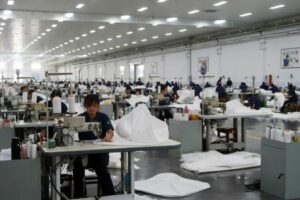By Jamie McGeever
ORLANDO, Florida (Reuters) – The virtuous cycle of loosening U.S. financial conditions and booming asset prices is accelerating rapidly as inflation continues to cool, which could be a problem for the Federal Reserve when it’s time to cut interest rates.
Surprisingly weak consumer and producer inflation this week has propelled Wall Street to new highs and pushed bond yields to two-month lows, while stock market volatility is near its lowest since before the pandemic and credit spreads are around the tightest levels since before the 2007-09 Great Financial Crisis.
These dynamics are playing out even though the Fed signaled via its new economic projections and Chair Jerome Powell’s press conference on Wednesday that no easing is imminent and that rates will be kept on hold throughout the summer.
In some ways, it is a perfect world for policymakers. Inflation is cooling and gradually heading back to target, growth is running above potential, investors are benefiting from record stock prices, real wages are rising, and unemployment is low.
What’s not to love?
The worry is that by signaling it is comfortable with the current economic equilibrium and prepared to sit tight for a few months, the Fed may also be backing itself into a corner.
Loose and even looser financial conditions will fuel risk-taking and speculative market activity, potentially inflating asset bubbles and increasing the damage when “something breaks,” as will likely be the case eventually.
That would force the Fed into a reactive and more aggressive series of rate cuts instead of a smoother, more managed decline – a hard landing, rather than the soft landing that many observers think is still possible.
“The defining features of the current environment continue to be loose financial conditions and low cross-asset vols supporting investor risk appetites,” Citi’s cross asset strategy team wrote on Tuesday.
“Markets are still trading a soft-landing narrative,” they wrote, adding that they are more positive on U.S. assets and have moved to an ‘overweight’ position in U.S. stocks and bonds.
And that was before the soft CPI and PPI data.
BY THE MINUTES
They’re not alone. Cross-asset strategists at HSBC on Wednesday wrote that the ‘Goldilocks’ and ‘immaculate disinflation’ narratives still warrant buying risk assets on any dip, even if these trades are beginning to look a bit crowded.
To be sure, pockets of stress are appearing, such as commercial real estate and private credit. But in broad terms, investors can hardly be blamed for staying bullish – by some measures, financial conditions are looser now than they were before the Fed first raised rates in March 2022.
Minutes of the Fed policy meetings show officials regularly discuss the ebb and flow of financial conditions. The minutes of the April 30-May 1 meeting show that “a number of participants” expressed concern that financial conditions at the time were not restrictive enough.
Back then, bond yields were the highest since November. Powell said in his May 1 press conference that the rise represented an “appropriate” tightening of financial conditions.
But financial conditions have loosened significantly since then. Is the recent fall in yields now inappropriate or, given the latest inflation readings, still appropriate?
Unfortunately, we may have to wait three weeks for the June meeting minutes to be published before we get an insight into officials’ thinking, because there was no mention of ‘financial conditions’ at all in Powell’s press conference on Wednesday.
This is the first time this has happened since September. Transcripts of Powell’s post-meeting press conferences since the Fed first raised rates in March 2022 show that there was no mention of ‘financial conditions’ in only three of them – Wednesday, and September and May last year.
Would the Fed cut rates with stocks markets at record highs? History suggests it would. According to Ryan Detrick at Carson Group, the Fed has done so 20 times since 1980, and a year after each one the S&P was higher.
A year is a long time, however. The summer months will be long enough for the Fed if the cycle of loose financial conditions, low volatility and booming asset prices continues to accelerate.
(The opinions expressed here are those of the author, a columnist for Reuters.)
(By Jamie McGeever; Editing by Andrea Ricci)


